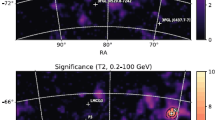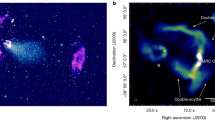Abstract
THE giant elliptical galaxy Cygnus A is regarded as the archetypal high-luminosity radio galaxy. These objects contain radio jets: an unknown energy source in the galactic nucleus generates two collimated outflows in opposite directions, which create radio hotspots where they interact with the surrounding intergalactic medium. Many radio galaxies are known to emit X-rays; in some cases these bave been shown to come from the central core region, and in others from an extended galactic halo. Here we report the detection of X-ray emission from the hotspots of Cygnus A, obtained with the High Resolution Imager of the Rosat satellite. We show that an explanation based on thermal bremsstrahlung from a hot gas is inconsistent with radio polarization data and that a synchrotron model would require a population of relativistic electrons distinct from that responsible for the radio emission. Inverse Compton scattering of radio photons by relativistic electrons in the hotspots is, however, able to account for the observed X-ray intensity. A model based on this latter mechanism allows us to calculate the average magnetic fìeld strength and the energy content of the relativistic electrons in the hotspots.
Similar content being viewed by others
References
Spinrad, H. & Stauffer, J. R. Mon. Not. R. astr. Soc. 200, 153–158 (1982).
Carilli, C. L., Dreher, J. W., Conner, S. & Perley, R. A. Astr. J. 98, 513–523 (1989).
Dreher, J. W., Carilli, C. L. & Perley, R. A. Astrophys. J. 316, 611–625 (1987).
Mannheim, K., Krulls, W. M. & Biermann, P. L. Astr. Astrophys. 251, 723–731 (1991).
Pacholczyk, A. G. Radio Astrophysics (Freeman, San Francisco, 1970).
Band, D. L. & Grindlay, J. E. Astrophys. J. 298, 128–146 (1985).
Band, D. L. & Grindlay, J. E. Astrophys. J. 308, 576–591 (1986).
Carilli, C. L., Perley, R. A., Dreher, J. W. & Leahy, J. P. Astrophys. J. 383, 554–573 (1991).
Harris, D. E., Perley, R. A. & Carilli, C. L. in Proc. Astronomical Data Analysis and Software Systems—III (eds Crabtree, D. R., Hanisch, R. J. & Barnes, J.) (Astr. Soc. Pacif. Conf. Ser., San Francisco, in the press).
Carilli, C. L. Dreher, J. W. & Perley, R. A. in Radio Hotspots in Extragalactic Radio Sources (eds Meisenheimer, K. & Roser, H. J.) 51–60 (Springer, Heidelberg, 1989).
van den Bergh, S. Astrophys. J. 210, L63–L64 (1976).
Yee, H. K. C. & Oke, J. B. Astrophys. J. 226, 753–769 (1978).
Author information
Authors and Affiliations
Rights and permissions
About this article
Cite this article
Harris, D., Carilli, C. & Perley, R. X-ray emission from the radio hotspots of Cygnus A. Nature 367, 713–716 (1994). https://doi.org/10.1038/367713a0
Received:
Accepted:
Issue Date:
DOI: https://doi.org/10.1038/367713a0
- Springer Nature Limited





